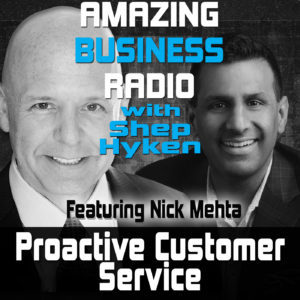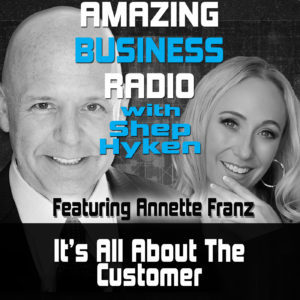Shep Hyken's Blog, page 136
December 4, 2018
Amazing Business Radio: Nick Mehta
 Proactive Customer Service
Proactive Customer ServiceHow to Ensure You Are Delivering Success For Your Customers
Shep Hyken sits down with Nick Mehta, CEO of Gainsight. They discuss why you should be proactive instead of reactive, how the subscription model is shaping customer loyalty, and why making your customers happy is no longer enough.








Shep Hyken’s opening monologue is about consistency. Three important points:
Your product has to meet the customer s needs every time.
Your omni-channel presence must have a consistent experience.
The attitude of the employees must be consistent.
Top Takeaways:
You have to proactively ensure that you’re delivering success to your customers. If you wait until they call you to voice their complaints, it may be too late.
Because of the subscription model and the numerous options available to consumers, they don’t have to be loyal to any one company. If you can’t deliver your customer’s desired outcome, they will find someone else who can.
Keeping your customers happy isn’t enough anymore. Today, they have to get more value from you than they can get anywhere else. This is why Jeff Bezos says he isn’t scared of his competitors. He’s scared of his customers, because they have the choice to leave every day.
Companies are realizing that they need somebody whose job is to ensure customers are getting maximum value. According to LinkedIn, the third fastest growing job title in 2018 is Customer Success Manager.
You have to proactively ensure your customers are achieving their desired outcome. Three ways to do that are:
Start at the beginning of the process by on-boarding the customer and getting them up to speed on how to use your product/service.
Ask them what it will take for them to continue doing business with you in the future.
Reach out to them over time to make sure they’re getting value and reaching their desired outcomes.
Quotes:
“You can’t just have the best product, you have to have the best outcome.” – Nick Mehta
“You re-earn your customers business every single day.” – Nick Mehta
“If you’re waiting for your customer to tell you what they want instead of being proactive and figuring that out yourself, they’re going to go somewhere else.” – Nick Mehta
“You’re never done delivering value and success to your customers.” – Nick Mehta
About:
Nick Mehta is the CEO of Gainsight. In his six years as CEO, he’s secured over $156 million in funding, expanded the employee base to over 500 employees, and been recognized as the third best SAAS CEO out of 5,000 nominees. He also co-authored the book Customer Success: How Innovative Companies Are Reducing Churn And Growing Recurring Revenue.
Shep Hyken is a customer service and experience expert, New York Times bestselling author, award-winning keynote speaker, and your host of Amazing Business Radio.
This episode of Amazing Business Radio with Shep Hyken answers the following questions … and more:
How can you be proactive with your customer service?
What is customer success?
Why are smart companies investing in customer success?
How can you keep customers longer?
What questions should you ask new customers?
The post Amazing Business Radio: Nick Mehta appeared first on Shep Hyken.
December 3, 2018
5 Top Customer Service Articles for the Week of December 3, 2018
Each week I read a number of customer service and customer experience articles from various resources. Here are my top five picks from last week. I have added my comment about each article and would like to hear what you think too.
How the leader in the cockpit builds a brand by Alaina Love
(SmartBrief) As any business road warrior will tell you, air travel these days is far from a relaxing experience.
My Comment: The captain of the airplane doesn’t just fly the plane – at least not this captain. On a recent flight, the author of this article met “Captain Adams,” who not only flew the plane but set the culture, empowered the crew and was the perfect example of a leader focused on the customer experience. There is a lot to learn from this short article about a commercial airline captain that recognized his job was to do more than just fly the plane. This is the way everyone should think.
The Mount Rushmore of Customer Service Leaders by John DiJulius
(The DiJulius Group) Who are the greatest Customer Service Leaders of all time? The following is a list of the 10 greatest Customer Service Revolutionaries who had the most influence and dramatically changed businesses in all industries. These changes are still being felt decades later.
My Comment: My good friend and fellow customer service expert, John DiJulius, has written a great article that showcases his ten favorite customer service leaders of all time. Starting with Walt Disney and ending with Sir Richard Branson, you can’t go wrong studying the way these leaders think. And, I love the “Mount Rushmore” photoshopped picture.
4 Negotiation Strategies for Managing Difficult Retail Customers by Dean Kaplan
(Retail Customer Experience) Difficult customers can cause stress for employees, damage to the bottom line, and thanks to social media, harm to the reputation of your business. These four strategies will help you negotiate with even the most unreasonable customer.
My Comment: While this article’s title claims to focus on the retail industry, the four tips in this article could apply to any industry. Here are four reminders of what to do with that angry and upset customer.
Customer retention is 5X cheaper than new acquisitions, but is it worth it? by Manish Nepal
(Freshchat) In essence, retention is a network effect that leads you to a sustainable growth trajectory. Retaining your most favorable customers is the best survival skill your business needs to fight churn and defy all odds in the market.
My Comment: The acquisition of new customers is important to any business, but doesn’t it make sense to keep the customers you already have? (That’s a rhetorical question.) This short article has some great reminders on how to keep your customers coming back, again and again.
How to improve customer experience: 2019 trends, strategy, & examples by David Peralta
(Hotjar) We recently asked 2,000 customer experience (CX) professionals about the state of their company’s customer experience strategies, methods, goals, and obstacles.
My Comment: We close this week’s Top Five with a robust article on customer experience trends you can expect in 2019. This is worth taking the time to read… more than once. There are plenty of strategies and examples to study and consider. Just to intrigue you, you’ll learn the “one thing” customer experience leaders prioritize above everything else,” the “#1 frustration customers face throughout their overall experience,” and more.
Shep Hyken is a customer service expert, professional speaker and New York Times bestselling business author. For information on The Customer Focus customer service training programs go to www.TheCustomerFocus.com. Follow on Twitter: @Hyken
customer service training programs go to www.TheCustomerFocus.com. Follow on Twitter: @Hyken
The post 5 Top Customer Service Articles for the Week of December 3, 2018 appeared first on Shep Hyken.
November 30, 2018
Guest Blog: 4 Easy Ways to Achieve Difficult Customer Contact Goals
This week we feature an article by Brian Cantor who gives us a list of ways to achieve success and consistency when communicating with customers on any channel. – Shep Hyken
Making for a jointly admirable and problematic reality, the customer contact community often takes a lofty, wide-eyed approach to strategy and technology.
Given the importance of competing on the customer experience, the idealistic approach is an encouraging sign. Today’s thought leaders and customer contact professionals clearly understand the importance of delivering exceptional experiences. They clearly view the CX function as an opportunity rather than an unavoidable cost.
Unfortunately, idealism too often becomes the enemy of action. If the ambition is too broad, the organization will struggle to determine the first step – and ultimately refrain from taking any action. If the vision is too aggressive, the organization will struggle to achieve results in the short-term – and lose faith in the endeavor.
This briefing will help you avoid those pitfalls. It reveals specific, immediate steps for achieving the lofty, high-level objectives that have the community buzzing. By taking these actions, you will achieve “quick wins” and position your organization for valuable long-term transformation.
Goal: Improve Customer Loyalty
Task: Remove one “no” from your vocabulary
The best policies and procedures do not compel agents to say no to certain customers. They instruct agents on why and how to say yes.
Do all your processes fall under the latter umbrella? If not, it is time to make a change.
To begin, identify the situation in which your agents most commonly say “no” to customers. This may involve your return policy, your strategy for handling missed flights, or your interest in repairing products after the warranty expires.
Upon identifying the problematic policy, devise a way in which you can more frequently say yes.
Whether this involves altering the policy or empowering agents to ignore the terms in certain situations, the move will result in more harmonious interactions – and more loyal customers.
Goal: Improve Agent Satisfaction
Task: Measure Agent Effort
When speaking about the agent experience, thought leaders often focus on parties, fun work environments, and elaborate compensation structures.
Actual customer contact agents, however, prioritize something else: the effort required to perform their work.
Agents obviously value bright contact centers and great salaries, but their daily happiness hinges far more greatly on systems and processes. Are the tools easy to use? Can they solve a customer’s problem without jumping through numerous hoops?
Reducing agent frustration is indeed the most surefire way to boost agent satisfaction, and measuring agent effort is a crucial first step in that process.
By establishing metrics for factors like “time spent in the knowledge base,” “screens to resolution,” or “questions to authentication,” you will learn what agents experience when supporting customers. This knowledge will, in turn, allow you to optimize backend tools and technologies.
Goal: Adopt Chatbots
Task: Identify a “gap” in the customer experience journey
Customer-centric organizations do not invest in chatbots for the sake of “keeping up with the Joneses.” They invest to meaningfully improve the customer experience.
The proper first step therefore involves identifying a clear pain point or efficiency gap within the customer engagement journey.
As an example, evaluate abandonment within your web self-service channels. If the abandonment rate is disproportionately high for a particular form of transaction, an opportunity for a bot may exist.
Alternatively, dissect average handle time for your agents’ phone conversations. If the majority of handle time for a particular issue is spent on “qualification” rather than “resolution” or “connection,” the issue is likely a simple transaction that does not benefit from a live agent conversation. A bot may be the optimal support mechanism.
Goal: Delivering a Consistent, Omnichannel Experience
Task: Define greatness within each channel
In reality, the first step to creating an omnichannel experience is to fully integrate all contact channels. Customers and organizations agree that the ability to seamlessly span channels is the hallmark of the omnichannel revolution. Trouble spanning channels, meanwhile, ranks as one of the biggest customer experience pain points.
That recommendation is, of course, the epitome of a cliché. You – and all your customer contact peers – understand the importance of eliminating channel silos. Inactivity is therefore not a question of awareness but a question of capability. If you are unable to invest in the technology needed to support seamlessness, it is not going to happen.
You can, however, embrace the omnichannel revolution without revamping your technology framework. You simply need to turn your attention to another tenet of the omnichannel experience: consistency.
In this case, consistency does not mean that the experience should be the same in every channel. A live chat interaction is obviously never going to mirror a voice conversation, which is obviously never going to mirror a social media thread. Consistency instead refers to a singular, on-brand commitment to customer centricity. No matter where or why they interact, customers should sense the same passion for understanding and resolving their issue.
To achieve that consistency, define “greatness” within each channel. Using the journey map, analytics and voice of the customer data, identify the specific factors that drive satisfaction within each channel.
No, this process will not seamlessly connect all your channels. It will, however, yield an experience that is valuable whenever or wherever customers choose to connect.
———————
JOIN US IN NASHVILLE THIS JANUARY FOR CUSTOMER CONTACT WEEK!
Customer Contact Week focuses on the best tools and strategies to achieve your organization’s customer contact goals. This year, CCW is celebrating 20 years in the industry, kicking off the celebration January 15-18 at the JW Marriott in Nashville, TN. See why 550+ industry executives are joining us: view more event information.
If you have any questions or would like the CCW Nashville event agenda sent to you directly, email info@customermanagementpractice.com .
Brian Cantor is the Principal Analyst for the Customer Management Practice. Brian leads all customer experience, contact center, technology and employee engagement research initiatives. Citing this proprietary research, Brian authors CMP’s series of special reports. Additionally, he serves as managing editor and director for CCW Digital, which is the largest web publication and community for customer experience professionals.
For more articles from Shep Hyken and his guest contributors go to customerserviceblog.com.

Read Shep’s latest Forbes article: Is A Subscription Model In Your Company’s Future? It Had Better Be!
The post Guest Blog: 4 Easy Ways to Achieve Difficult Customer Contact Goals appeared first on Shep Hyken.
November 28, 2018
Let Your Customers Tell Your Story
 In the past, I’ve written and talked about “Telling Your Story.” The idea is that you look to create the “legendary” type of stories that come from your employees and set the bar for the customer experience you want to deliver. Probably the best example is the famous Nordstrom story where a customer returned a set of used tires to a Nordstrom – and the store employee gave the customer a refund. We all know that Nordstrom doesn’t sell tires. If you don’t know the entire story, you can simply Google “Nordstrom Tire Story” and you’ll find plenty of information confirming the validity of the story.
In the past, I’ve written and talked about “Telling Your Story.” The idea is that you look to create the “legendary” type of stories that come from your employees and set the bar for the customer experience you want to deliver. Probably the best example is the famous Nordstrom story where a customer returned a set of used tires to a Nordstrom – and the store employee gave the customer a refund. We all know that Nordstrom doesn’t sell tires. If you don’t know the entire story, you can simply Google “Nordstrom Tire Story” and you’ll find plenty of information confirming the validity of the story.
The traditional way to get your story used to be to ask employees to share their best examples of the customer experience they created for a customer. Or, maybe a customer might write an accolade letter. Well, thanks to social media and online review sites, the customer now has a voice in your “Tell Your Story” efforts.
Yes, we hope for positive reviews on the different review sites, Google and Facebook. But why stop there? Why leave it to chance for your customers to leave those positive comments? Why not create a campaign that gets the customers who love you to not only share but get some attention for themselves?
So, here’s my idea. Have your customers create videos that tell the story of what it’s like to do business with you. You could create a contest. Customers submit videos about how much they love doing business with you and why. This can be shot using an iPhone, although some may want to bump up the experience and do something more professional looking. It really doesn’t matter, as long as they send something.
By the way, why just do it with your customers? Why not do it with employees? One of my clients had an internal contest where groups of people, mostly within their own departments, although not always, submitted short three-minute videos. It was a great teambuilding experience. Once the videos were submitted, the company had a viewing party and awarded an “Oscar” statue for the team that created the best video, which by the way, was chosen by the audience – as in fellow employees.
Back to your customers. Their testimonials are powerful. Putting that into a video form means additional exposure compared to the written accolade. Consider putting these videos on your website and/or a YouTube channel. Be sure to ask permission before you do. Ask them to be honest, but also to have fun. You’ll be surprised what you get. As a thank you gift for submitting their video, send them the replica Oscar statue I mentioned to give employees. It’s a fun way of showing your appreciation and ties in with the “movie theme.”
Think about the power behind real people – or should I say, real customers – sharing their story about you on video. It’s powerful and different. Okay… That’s a wrap!
Shep Hyken is a customer service expert, keynote speaker, and New York Times bestselling business author. For information, contact 314-692-2200 or www.hyken.com. For information on The Customer Focus customer service training programs, go to www.thecustomerfocus.com. Follow on Twitter: @Hyken
customer service training programs, go to www.thecustomerfocus.com. Follow on Twitter: @Hyken

(Copyright © MMXVIII, Shep Hyken)
The post Let Your Customers Tell Your Story appeared first on Shep Hyken.
November 27, 2018
Amazing Business Radio: Annette Franz
 It’s All About The Customer
It’s All About The CustomerUsing Journey Mapping to Put the Customer Back into the Customer Experience (CX)
Annette Franz returns to Amazing Business Radio to discuss becoming more customer-centric, how to understand your ideal customer, and journey mapping.








Top Takeaways:
The only way you’re going to design a product or service that customers will want and need is to understand their pain points, what problems they’re trying to solve, and what they’re trying to do.
Creating a product is grounded in data, insight and customer understanding. Customer understanding can be achieved in three ways:
1. Listen: Listening to the channels your customers are on and “listen” to existing customer data.
2. Characterize: Developing personas instead of target demographics or segments.
3. Empathize: Walk in your customers’ shoes and create a journey map
Instead of always ending the customer experience with the survey, you can take an extra step by listening to your customers on places like social media. The goal is to be where your customers are when they want to provide feedback.
A Persona is a researched-based representation of your ideal customer. Organizations can have multiple personas for customers that have similar preferences, likes, needs, and pain points.
Five reasons why every organization should journey map:
1. There’s no better way to understand the experience, what’s going right and what’s going wrong.
2. Journey mapping helps you design new and better experiences.
3. They are great communication and training tools for employees. You can use journey maps to train employees on what the experience should look like and align your organization around the customer.
4. Journey maps allow you to show instead of tell, which increases your chance of getting an executive commitment towards CX transformation.
5. Journey maps give employees who don’t usually interact with customers a clear line of sight to the customer.
Quotes:
“Customer understanding is the cornerstone of customer centricity.” – Annette Franz
“Employees drive the customer experience.” – Annette Franz
“You have to lead with the customer in everything you do.” – Annette Franz
About:
Annette Franz is the CEO of CX Journey. For the last 25 years, she’s helped companies understand their employees, customers, and what drives engagement and retention.
Shep Hyken is a customer service and experience expert, New York Times bestselling author, award-winning keynote speaker, and your host of Amazing Business Radio.
This episode of Amazing Business Radio with Shep Hyken answers the following questions … and more:
Should you focus on the customer when creating a product?
How can you listen to customers?
What are some alternatives to surveys?
What are personas?
Why should you journey map?
What is a journey map
The post Amazing Business Radio: Annette Franz appeared first on Shep Hyken.
November 26, 2018
5 Top Customer Service Articles for the Week of November 26, 2018
Each week I read a number of customer service and customer experience articles from various resources. Here are my top five picks from last week. I have added my comment about each article and would like to hear what you think too.
Busting 3 Massive Myths About Employee Engagement by Christine Comaford
(Forbes) There’s a lot of buzz about employee engagement these days. But the sad truth is that engagement stats worldwide are still dreadfully low. And to throw some fuel on the fire, myths about what actually creates engagement are rampant—and are making the problem worse.
My Comment: If employee engagement is important to you, then this may be one of the most important articles you read this year. That’s a bold statement, but it’s true. I’ll leave it at that and hope you are intrigued enough by my hyperbole to spend five minutes reading this article.
No, I Don’t Want to Take Your Survey By Gerry McGovern
(CMSWire) Take your survey? Why on earth would I want to do that? Help you improve your website? Am I your employee? Are you my boss? Last time I checked, I wasn’t. So, do your job. It’s not up to me to help you make your website better. What do I think of your new redesign?
My Comment: I smiled when I read this article. It comes off as a rant. Take 90 seconds and you’ll smile, too. You may even laugh. But, make sure you get the point. Do customers really want to take your survey? Many will, but do they really want to?
To Improve Customer Experience, Start With Morale, Not Technology, Feds Say by Tom Shoop
(Nextgov) Cultural factors, such as empowerment of staff, given greater weight than upgraded IT and bigger budgets.
My Comment: This short article reminds us that no matter how much you are investing – or plan to invest – in technology to deliver a better customer experience, your first investment should be in the morale of your people.
Customer Retention Made Easy by Samir Palnitkar
(The Wise Marketer) Companies are realizing the importance of focusing on their repeat customers and designing special loyalty rewards program exclusively for this category of customers.
My Comment: In the 1980’s I read that it costs five times more to acquire a new customer than to keep an old one. Boston Consulting group confirms that the numbers haven’t changed much; $7 to keep an existing customer versus $34 to acquire a new one. And not only that, happy and loyal customers do more than come back. They tell others. Here are a few ideas on how to retain those happy customers.
Customer Experience by Tom Fishburne
(Marketoonist) Singapore Airlines has long been a pioneer in customer experience, not just in airlines, but the hospitality industry in general. They’re investing in taking their customer experience even further, partly with a sophisticated app that tracks granular customer data from check-in, through the flight, to baggage claim.
My Comment: Let’s end this week’s Top Five list with a fun article from Tom Fishburne of www.Marketoonist.com. I love business cartoons, and Tom has shared several of his favorites. There a lesson or two you’ll get from them as well.
Shep Hyken is a customer service expert, professional speaker and New York Times bestselling business author. For information on The Customer Focus customer service training programs go to www.TheCustomerFocus.com. Follow on Twitter: @Hyken
customer service training programs go to www.TheCustomerFocus.com. Follow on Twitter: @Hyken

The post 5 Top Customer Service Articles for the Week of November 26, 2018 appeared first on Shep Hyken.
November 23, 2018
Guest Blog: The 8 Elements of Customer Support Quality
This week we feature an article by Pascal van Opzeeland who writes about the quality of customer support and what it takes to provide great customer support. – Shep Hyken
What makes a customer support interaction good or bad?
One could claim that quality is in the eye of the beholder, but that’s only partially true. When we break things down into core principles, we see that we all yearn for certain attributes while abhorring others.
Personal tastes vary in how individuals rank these elements in order of importance, but specifying them allows companies to deliberately improve their support setup over time – be it through tools, people, or organization.
To be good, a customer support interaction needs to be…
Element #1: Fast
The speed of service delivery has a massive effect on how customers view your support. Over and over again, speed and responsiveness show up in studies as main determinants of service satisfaction.
To deliver superior service, track metrics like First and Average Response Time, and First Contact Resolution Ratio.
Your service speed depends on factors like the contact channel (e.g. chat is faster than email), training (a knowledgeable employee can respond without research or escalation), and empowerment (an empowered employee can bend the rules to quickly resolve corner case issues).
Element #2: Accurate
An accurate reply won’t necessarily increase satisfaction, but a lack of accuracy will definitely decrease it. Accuracy is a baseline. Customers expect correct information from support.
Training is essential to guarantee accuracy, and so is a system for delegating issues to the right colleagues, and carefully integrating information in the right spots in the customer journey.
Element #3: Clear
How well do your customers understand what your support explains to them? Especially when the explanation turns technical, it’s easy for customers to lose track.
The first key to clarity is simplicity. Use fewer, better words. Tech support often errs by diving into detailed explanations. Instead, skim the fat off what you’re trying to
say and focus on the big picture. Use simple and familiar words (no jargon!), shorter sentences, and minimize commas and dependent clauses.
Next, practice structuring your sentences. A clear structure allows the customer to break up your explanation into manageable chunks. A popular sales structure is Features- Advantages- Benefits. A useful support structure is What? So What? Now What?
Element #4: Transparent
People don’t only care about the end result, we like to know what’s going on behind the scenes.
Understanding calms the customer’s mind, so let them know what’s happening and how you’re solving their problem. It is painful, for example, to wait without knowing why or for how long. This information makes for a far more patient and satisfied customer.
Humans have a driving need to know why. Once given a reason, we’re far more likely to accept whatever the company offers. So although speed is important, don’t sacrifice it for speed.
Element #5: Accessible
How easy is it for customers to get in touch with you? Difficulty here escalates any already existing frustration. Reduce effort for the customers, on the other hand, and you’ll go far in improving the customer experience.
In fact, reducing customer effort is shown to be more important to the customer than exceeding expectations. Measuring the Customer Effort Score (CES) through postservice or in-app surveys will give you a good idea of your company accessibility.
Consider the number of actions customers have to take to get in touch. Do they first need to find a contact page to find your phone number or email address, or do they always have a chat window option available? Any reduction in steps directly improves the customer experience.
Element #6: Empowered
People like to feel in control. Aim for that feeling throughout your support interactions.
Service reps who can bend the rules give customers a feeling of control. People don’t want to be enslaved to rules, especially not if their circumstances are outside the typical guidelines.
Also, the ability to comment on the service they received, through a rating or comment system, gives customers a feeling of control. It allows them to feel like they can do something with the service they received, whether it was good or bad.
For independent customers, the ability to do things themselves gives them a sense of empowerment. Self-service options let the customer take care of themselves without assistance.
Element #7: Friendly
This element is crucial to each customer service interaction, but it’s also the element that’s rather difficult to train in for your support reps. This is where the importance of hiring becomes evident.
Whether your support is friendly or not depends largely on language use of your support reps. Their words, for example, should be all about your customer. In this you-focused language, the customer is at the center. Instead of “Our new product is faster than ever”, consider “You can be faster than ever with our new product”. The first is all about your company; the second is about how the customer benefits.
For more tips on how to make your service more humane and less robotic, check out our post on the uncanny valley of customer service.
Element #8: Efficient
Efficiency goes a long way in making your service less expensive and improving your profits. Just like customers demand a positive interaction, efficiency means a better interaction for your bottom line.
Technology has made it easier than ever to increase company efficiency without compromising on quality. Live chat allows one representative to serve up to 10 customers at once, thus allowing you to offer great support while keeping costs low.
Great customer support doesn’t require bigger spending per se. Through small, efficient changes, you can offer the kind of support that keeps your customers coming back.
 Pascal van Opzeeland is CMO of Userlike, software for website and messaging support. He and his team share tips about customer service and communication on the Userlike Blog.
Pascal van Opzeeland is CMO of Userlike, software for website and messaging support. He and his team share tips about customer service and communication on the Userlike Blog.
For more articles from Shep Hyken and his guest contributors go to customerserviceblog.com.

Read Shep’s latest Forbes article: Thanksgiving Day Woes Disappear With Butterball Turkey Talk-Line
The post Guest Blog: The 8 Elements of Customer Support Quality appeared first on Shep Hyken.
November 21, 2018
Five Ways to Create Customer Loyalty
 Customer loyalty… This is what companies strive for, to create loyal customers. Some companies have earned a reputation that keeps bringing their customers back, again and again. How do they do it?
Customer loyalty… This is what companies strive for, to create loyal customers. Some companies have earned a reputation that keeps bringing their customers back, again and again. How do they do it?
That’s a big question, and entire books have been written about this, but that doesn’t mean we can’t have a few tips to get us started in the right direction. Here is a short list of ideas, some new and some old. If you’ve been following me for some time, you may recognize a few of these, but they are worth hearing again.
Have a Good Product: This is a given. The product must do what it’s supposed to do. If it doesn’t, it doesn’t matter how good your customer service is. People need to know they can count on your product, not just your customer support department.
Customer Service and Support: It’s a given that everyone in your organization will deliver a level of customer service that meets, if not exceeds your customers’ expectations. And, if you have a customer support department, you must offer amazing support. This is obvious to most, yet it still surprises me how reaching a live agent for support is sometimes a Moment of Misery
 . I often jokingly refer to a poorly run customer service department as the future sales prevention department. By the way, being amazing doesn’t mean you’re delivering over-the-top customer service. It means you’re better than average – even just a little better than average – all of the time!
. I often jokingly refer to a poorly run customer service department as the future sales prevention department. By the way, being amazing doesn’t mean you’re delivering over-the-top customer service. It means you’re better than average – even just a little better than average – all of the time!Tell the Customer How Good You Are: Remind the customer they made the right decision to do business with you – but do it in a way that’s not arrogant. What do you do differently than your competition? As long as it’s something the customer will appreciate, make sure the customer knows about it. Don’t keep your differentiator a secret.
Be Employee Focused: Focus on creating loyal employees and you’ll create loyal customers. I’ve talked and written about this often: What’s happening on the inside of the organization will be felt on the outside by the customer. It isn’t a coincidence that the best places to work are also recognized as the organizations that deliver the best customer service.
Focus on the Next Time: Finally, customer loyalty can eventually be about a lifetime, but to make it more attainable, take it one step at a time. Whatever situation you’re in, good or bad, ask yourself what I refer to as the Loyalty Question: “What am I doing right now that will make the customer come back the next time they need what we sell?” It’s not about a lifetime. It’s about the next time, every time.
Shep Hyken is a customer service expert, keynote speaker, and New York Times bestselling business author. For information, contact 314-692-2200 or www.hyken.com. For information on The Customer Focus customer service training programs, go to www.thecustomerfocus.com. Follow on Twitter: @Hyken
customer service training programs, go to www.thecustomerfocus.com. Follow on Twitter: @Hyken
(Copyright © MMXVIII, Shep Hyken)
The post Five Ways to Create Customer Loyalty appeared first on Shep Hyken.
November 20, 2018
Amazing Business Radio: Tien Tzuo
 The Subscription Economy
The Subscription EconomyWhy the Subscription Model is the Future and What to Do About It
Shep Hyken sat down with Tien Tzuo to talk about the subscription model and how companies like Salesforce, Uber, and Caterpiller are helping to make it the future of business.







Top Takeaways:
The subscription economy is a phrase coined to describe the idea that people don’t have to buy products anymore to meet their everyday needs or to get from Point A to Point B. It allows companies to switch from selling products to selling a service that consumers can use while transforming an industry for the better.
The subscription model is a win-win for customers and businesses. For businesses: It scales better, is easier to run, and guarantees recurring revenue. For the customer, it’s less expensive and more convenient.
To jump into the subscription economy, start with a view of what your customers are doing with you and track all of the usage and interactions. This allows you to understand how you can broaden your footprint with the customer and create a more meaningful relationship.
Anybody can take your product, reverse engineer it, and offer a clone to their customers. If your competitive advantage isn’t based on your product but instead your knowledge of what your customers are doing and the relationships you have with them, that is a much stronger position to be in.
Quotes:
“Once consumers taste a subscription service, they’ll start asking why can’t everything be like Uber, Netflix, or Salesforce?” – Tien Tzuo
“In the future, all aspects of our lives will be run by subscription services.” – Tien Tzuo
“It’s easy to steal a product, It’s harder to steal the knowledge of your customers and relationships you have with them.” – Tien Tzuo
About:
Tien Tzuo is the CEO and founder of Zuora. Previously, he was the 11th employee of Salesforce working as the Chief Strategy Officer and CMO for eight years. He’s also the bestselling author of Subscribe: Why the Subscription Model Will Be Your Company’s Future and What to do About It.
Shep Hyken is a customer service and experience expert, New York Times bestselling author, award-winning keynote speaker, and your host of Amazing Business Radio.
This episode of Amazing Business Radio with Shep Hyken answers the following questions … and more:
What is the subscription economy?
Is the subscription model disrupting traditional business?
How can companies get started in a subscription model?
What’s the competitive advantage of the subscription model?
How can companies create a 1-1 relationship with customers?

The post Amazing Business Radio: Tien Tzuo appeared first on Shep Hyken.
November 19, 2018
5 Top Customer Service Articles for the Week of November 19, 2018
Each week I read a number of customer service and customer experience articles from various resources. Here are my top five picks from last week. I have added my comment about each article and would like to hear what you think too.
Customer Service Rookie Mistakes That Could Be Tarnishing Your Business Image! by Deeksha Dadu
(CustomerThink) Let’s face it, poor customer care support service can cost a business a fortune!
My Comment: Don’t let the article fool you. Many of the customer service mistakes mentioned in this article aren’t “rookie mistakes.” Unfortunately, they are found in companies that have been around for many years. What makes them appear to be “rookie mistakes,” is that they could be easily avoided.
How psychology affects the customer experience of voice support by UJET
(UJET) When done right, a conversation with the customer over the phone can be helpful, engaging, and even fun. The problem with voice support is that it can also go terribly wrong, and those are the types of interactions that people hear about.
My Comment: Even with self-service and automated customer service solutions, some customers still want to (and sometimes have to) talk to a human being. There was a stat in the article that caught my eye: “On average, US customers spend more than thirty hours per year on the phone with customer support.” That’s three-quarters of a typical work week! And, it’s not because they want to call. It’s because they have to call to have a question answered or a problem resolved.
How to Find Value in Every Customer by Knowledge@Wharton
(Knowledge@Wharton) The Customer Centricity Playbook: Implement a Winning Strategy Driven by Customer Lifetime Value is designed to guide businesses to the next level, where success is measured beyond mere dollars. Fader and Toms recently spoke on the Knowledge@Wharton radio show on SiriusXM about the importance of being customer centric.
My Comment: When people from Wharton Business School talk or write, I listen and read. This is an interview with Peter Fader (Marketing professor at Wharton) and Sarah Toms (executive director of Wharton Interactive), the authors of “The Customer Centricity Playbook.” About halfway into the article, there was a profound comment by Professor Fader: “We are not going to judge ourselves by the least happy customer, we are going to judge ourselves by the most valuable customers.”
Harnessing the Power of Video for Customer Service: 5 Tips by Sean Gordon
(Chief Marketer) Video is great for creating social engagement, but it can also be a powerful customer service tool. Here are five ideas for using video to help maximize customer experience with your product or service.
My Comment: I’ve always felt video was a powerful customer service tool. At the same time, it can be a powerful marketing tool. This short article shares five ways to use video to enhance the customer experience, including how-to videos, clients sharing how they best use the company’s products and more.
How Human-Centric Design Thinking Can Improve the Customer Experience by Kindra Cooper
(LinkedIn) Given the deeply human-centric nature of hospitality, luxury hotels are under intense pressure to get into their customer’s hearts and minds to differentiate from their competition – but so is any profit-seeking business.power of video
My Comment: CX Design is a hot topic recently. Understanding the experience a customer has with your organization, and designing that experience to give the customer the very best, is not a simple task. This short article shares several great ideas to simplify the process.
Shep Hyken is a customer service expert, professional speaker and New York Times bestselling business author. For information on The Customer Focus customer service training programs go to www.TheCustomerFocus.com. Follow on Twitter: @Hyken
customer service training programs go to www.TheCustomerFocus.com. Follow on Twitter: @Hyken

The post 5 Top Customer Service Articles for the Week of November 19, 2018 appeared first on Shep Hyken.



